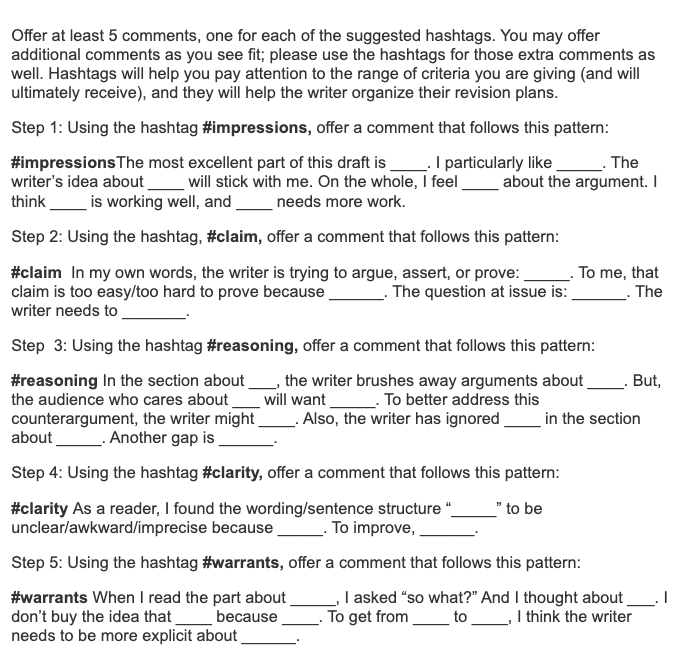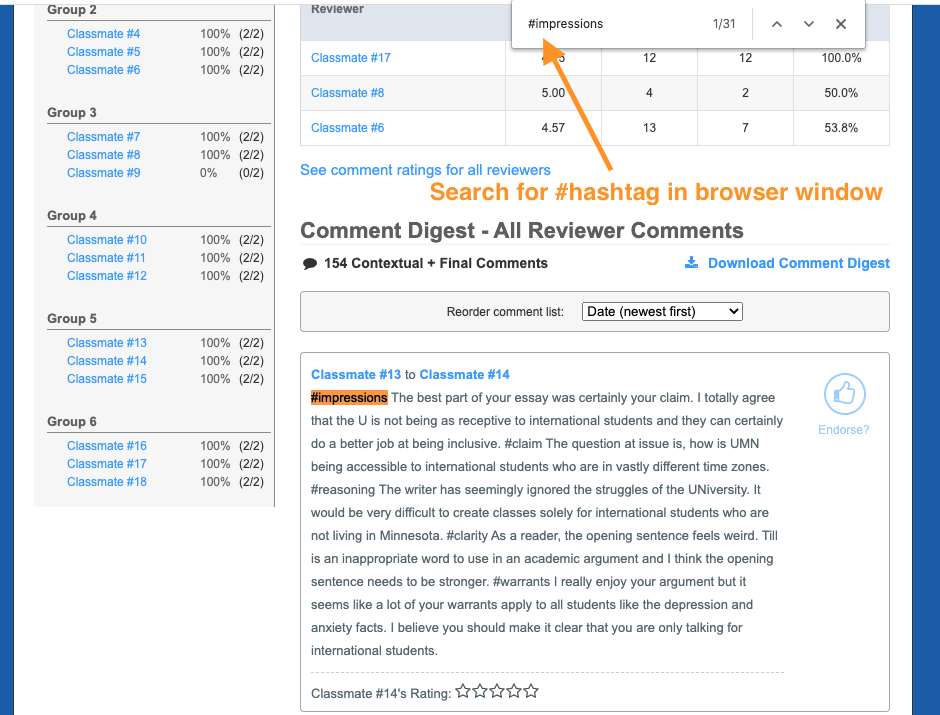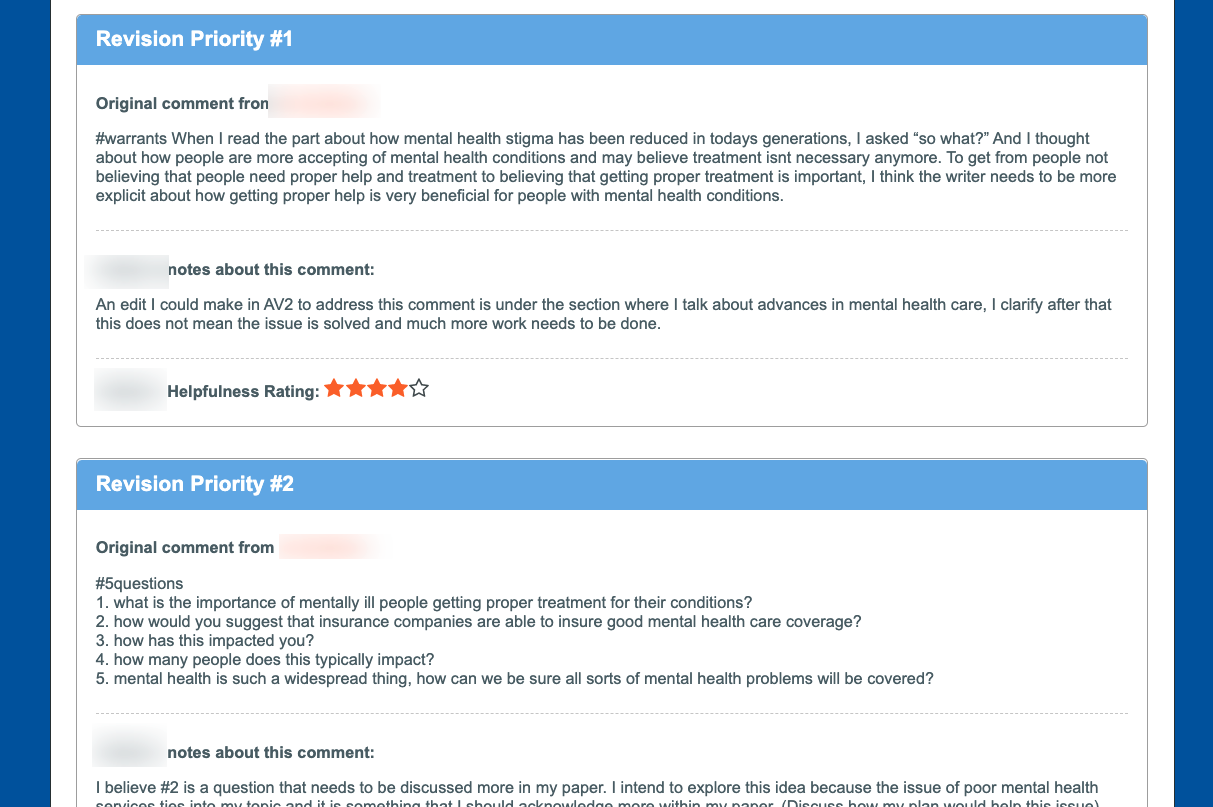At Eli Review, we love to hack the app so that instructors can guide students in giving and using better feedback.
#Hashtags are used to identify topics. On social media platforms like Twitter, searching a #hashtag will show all the posts that include it.
Mike Edwards from Washington State University first shared the idea of #hashtag comments in 2015; we’ve taken Mike’s sophisticated corpus analysis strategy and pared it down to work within the app.
This hack involves three parts:
- Directing students to use hashtags in the review task prompt.
- Using search to read comments with the same hashtag in the comment digest.
- Encouraging students to use hashtags to group similar feedback when prioritizing in revision plans.
Allison Brenneise from University of Minnesota used this approach in her Communication Studies course by encouraging students to organize their revision plans by #hashtag. Below, you can see how the instructions in the Contextual Comment section of Brenneise’s review task guide students in writing their feedback. Then, the browser’s search features let her read through comments by #hashtag. Finally, writers can use the #hashtag comments to prioritize their revision goals, making it easy for writers to group feedback from different peers on the same aspect of the draft and easier for Brenneise to make sense of writer’s plans.
1. Contextual Comment prompt (click for full review task)

2. Search #hashtag in the browser
Instructors can read all the comments by all reviewers in the Review Feedback’s comment digest (learn more).
Eli Review’s comment digest does not yet organize comments by #hashtags in the same way as Twitter, but including #hashtags in the comments makes it easier for writers, reviewers, and instructors to notice trends in feedback. For example, the browser’s search feature will find all instances of the tag in the Review Feedback tab’s comment digest:

Reading through a couple of comments with the same #hashtag can help instructors know if students understand the criteria. Also, showing a couple of comments during the debriefing session after peer review builds a culture of helpful feedback.
3. Revision Plan with #hashtags (click for full revision plan)
When writers build their revision plans (watch tutorial), the #hashtags help them group similar feedback and prioritize it accordingly.

Benefits
By asking reviewers to #hashtag their comments, several benefits occur:
- Reviewers pay more attention to whether their feedback covers all the required aspects of the assignment.
- Instructors can more easily scan the comment digest for themes and can assess whether reviewers have met the minimum expectations.
- Writers can more easily tell what the point of the reviewer’s feedback is and what part of their draft needs to be revised.
See More Examples
Several instructors have experimented with using #hashtag comments, and the links below show all the questions in the review tasks with the instructions for #hashtag comments called out.
- First-year writing course used #praise and #critique in a review of a final draft of an argument. (See the full review.)
- Professional Writing class used #tone, #content, #wordy, and #grammar in a peer review of business letters. (See the full review.)
- Pharmacy course used #praise and #critique plus a hashtag for each of the required sections. (See the full review.)
- Nursing course used hashtags for the SQUIRE format. (See the full review.)
Try It in Your Course
If you’d like to experiment with #hashtag comments, copy and paste these instructions into the Contextual Comment section of a review task, modifying as you see fit:
Offer at least 2 comments. Make sure to click “Add comment” two times so that each comment is separate.
Begin your comment with a #hashtag and then offer feedback that describes the writer’s ideas in your own words, evaluates how well that part of the draft meets the criteria, and then offers a suggestion. Hashtags will help you pay attention to the feedback you are giving, and they will help the writer organize their revision plans.
—-Example comments—-
#praise The alternative perspective on ____ really got my attention because ____. It made me think about _____, which _____. You could build on this strength by ____.
#critique As a reader, I felt bogged down in the evidence in the section ___. To me, it seems like you could add ____, maybe about ___. In my view, you need something to help readers ___ in that part of the draft.



